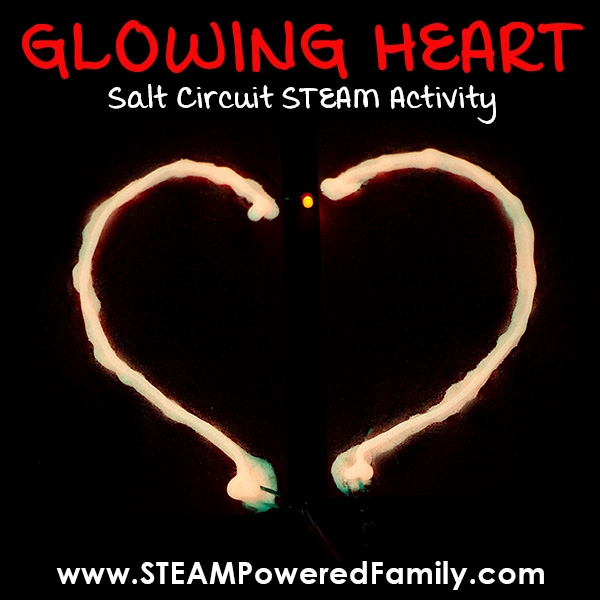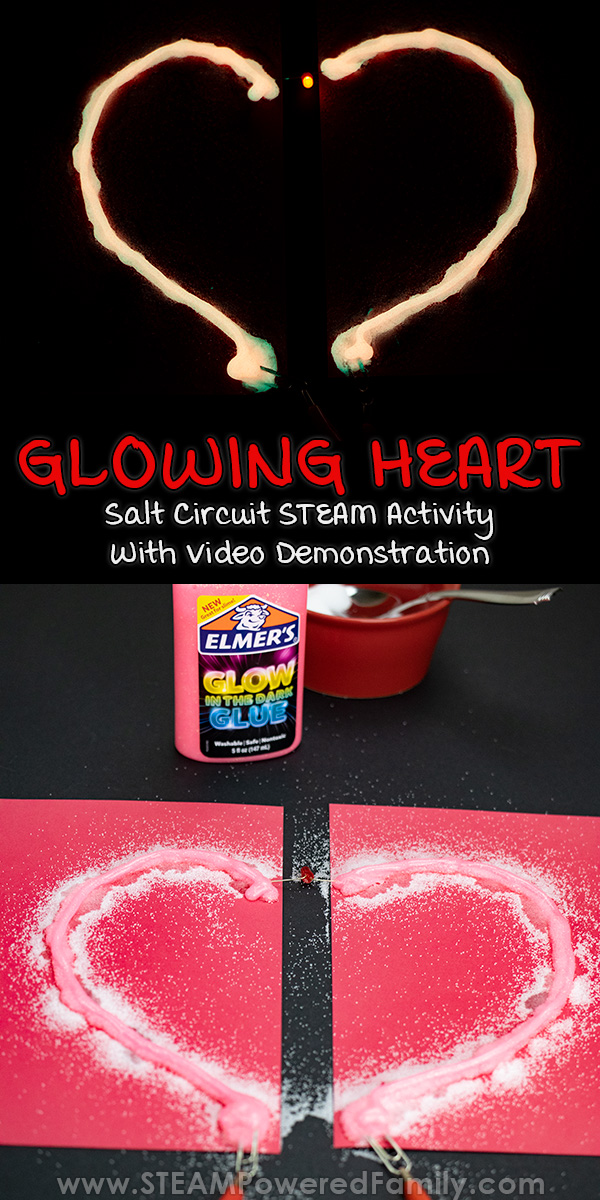Valentine’s Day Glow LED Circuit STEAM Activity
I like to think that Valentine’s Day is not just about love but about celebrating our connections to others. It is also a fun holiday that kids really love. This Valentine’s Day circuit is a great way to show someone how they “complete you”, light up your life and any other corny says you want to add! Overall it is simply another fun way to bring some STEAM into your lesson plans as we create some cool art, make circuits, learn about electricity and the science behind glow.
VALENTINE’S DAY STEAM – GLOW HEART SALT CIRCUIT FOR KIDS
Disclaimer: This post contains commission and affiliate links.
As the seasons change it is always fun to see how certain activities come back up again, with a few tweaks. In October we created a fun glow salt circuit activity for Halloween. With Valentine’s Day coming up it was time to pull out the salt again for a new heart salt circuit activity, with some glow. The great part about redoing these types of activities throughout the seasons is that it helps reinforce the concepts and ideas. With a bit of practice, your kids will be pulling out the supplies and building their own circuit projects with confidence.
I like to think that Valentine’s Day is not just about love but about celebrating our connections to others. It is also a fun holiday that kids really love. This Valentine’s Day circuit is a great way to show someone how they “complete you”, light up your life and any other corny says you want to add! Overall it is simply another fun way to bring some STEAM into your lesson plans as we create some cool art, make circuits, learn about electricity and the science behind glow.
The last circuit activity we built was a super fun Harry Potter Lumos Wand. And before that? A glow salt circuit! We had so much fun making that glowing circuit for Halloween that the kids were asking to do it again.
I gave it some thought and realized we had a great project in the making if we went with a heart design. The shape of the heart is perfect for salt circuits. Now we could have done this with regular glue, but that wouldn’t be as much fun as a glowing circuit. So we broke out a bottle of pink glow-in-the-dark glue from Elmers. See there are other things you can do with Elmers other than making slime!
The good news is that you probably have everything you need already on hand for this project. And the satisfaction when that little LED lights up is unbelievable! Just prepare yourself to spend a few extra minutes on this activity to get that electricity flowing!
Supplies for Glow Heart Salt Circuit Activity
Construction paper (we used red for Valentine’s Day, plus a large black sheet underneath to protect the table)
Elmers Glow Glue in Pink
Table Salt
Scissors
Pencil
LED light (we used a red one)
2 Paperclips
Alligator clips with wires
AA Double Battery Pack with batteries (I don’t have a double one, so we chained two since AA battery packs to each other)
Video of Heart LED Circuit For Valentine’s Day
Check out this video of the whole process as I made a heart LED circuit for Valentine’s Day.
LED HEART CIRCUIT MAKING FOR KIDS
The first thing I recommend is covering your table. This is to prevent glue getting onto the table and keep the salt somewhat contained.
Now make sure to test your LED light bulb. There is nothing more frustrating than doing the whole project only to discover your LED doesn’t work. To test it simply attach the leads from your battery pack to the legs of your LED. If it doesn’t work switch the leads just in case you reversed the + and – leads. If it still doesn’t work try another LED. Still not working, try new batteries. Still not working, try new leads. This is the time to test and investigate until you get that LED to light up!
Now you have a working LED let’s build a glow salt circuit. But make sure you take note of the + and – legs of your LED and leads off your battery pack.
Start by cutting your paper in half. Place them on the table about 1 inch apart. Now draw a heart so half of the heart is on each side. You can also draw the heart before cutting the paper if you prefer.
Take your glue bottle and carefully squeeze a nice thick line of glue along the lines of your heart. Make it a little extra thick at each of the four end points.
Clip your alligator clips onto paperclips and place the paperclips into the bottom points of the glue heart. Use a little extra glue on top to make sure the paperclips is completely covered.
Now spread the legs of your LED bulb and place it between the top two end points of your heart.
Attach your battery pack to the alligator clips if it isn’t already attached.
Now liberally sprinkle all your glue with table salt. Make sure you really cover it.
Your LED should light up.
Turn off all the lights to unveil your glowing heart with light up LED!
WHAT IF YOUR LED DOESN’T LIGHT UP IN YOUR CIRCUIT
Now since you have already tested the LED, battery pack and alligator clip wires, we know all of those work fine. I am also going to assume you kept track of the + and – so all of that is hooked up in the right order.
That means the issue is with your glue salt circuit.
My first tip is to turn off the lights. Since the electricity is traveling through the glue, the LED is not getting as much power as it did with a direct connection. A few times we have mistakenly thought our circuit wasn’t working, only to realize it was. We simply couldn’t see it clearly with the lights on.
If it still is not working, add more glue to any thin spots, or add a whole extra line of glue to the entire circuit. Then sprinkle again with salt. This should get your circuit working.
Need more trips? Check out our other Glow LED circuit project for more ideas.
THE SCIENCE BEHIND GLOW LED CIRCUITS
There are two types of science involved in the lighting of our hearts. The science behind the glow and the science behind the electrical circuit.
The Elmers Glow In The Dark Glue glows thanks to a process called luminescence which is caused by chemicals called luminescent phosphors in the glue. For this glow to work it needs to charge in the light. You will have the brightest glow when you first turn off the lights, then it will fade. You can “recharge” the glow simply by turning on the lights again for a minute. Where we were a bit disappointed, we though the pink Elmers glow glue would be more pink when glowing. It really wasn’t as pink as we had hoped.
The science behind the electrical circuit is quite fascinating. Saltwater is very conductive. So when you add salt to your glue (which has water in it) the electrical current can travel from your battery pack, along your circuit, eventually turning on your LED light. The current travels from salt molecule to salt molecule, and works best if the salt is quite wet. This is why I like to place a line of glue, then add salt, then cover the salty line with another layer of glue with a bit more salt. It all helps move that current along to it’s destination – the LED!
But this also explains why your circuit will become less effective over time. As the glue dries it is losing that all important water and without that it can’t conduct the electricity properly.















